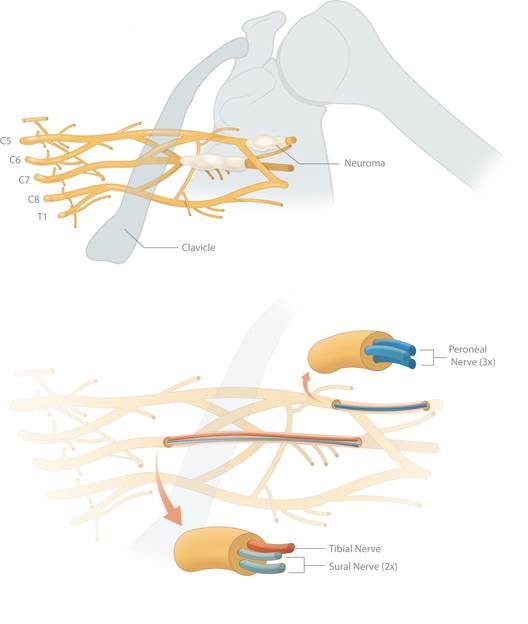A Rare Case of Abundant Nerve Autograft: Using An Amputated Limb to Reconstruct Large Nerve Gap
Matthew WT Curran, MD; Michael Morhart, MD, M.Sc; Jaret L. Olson, MD; K. Ming Chan, MD
University of Alberta, Edmonton, AB, Canada
Introduction:Long nerve gaps present a reconstructive challenge. Although many types of graft repair have been tried, clinical outcomes in most cases remain poor. Autografts from sensory nerves are among the most widely used but scarcity of donor nerve is a major constraint.Here we present the clinical outcome of a rare case of severe brachial nerve injury that underwent long gap reconstruction using abundant autogenous grafts.
Case Discussion: A 42 year old mechanic involved in a vehicle rollover accident sustained multiple orthopedic injuries including a femur fracture.In addition, on initial evaluation, he was also found to have profound weakness of shoulder external rotation and abduction, elbow flexion and extension and wrist extension. EMG confirmed severe denervation with no recruitable units in the biceps, deltoid, and biceps muscles.At 6 months, there was no functional recovery necessitating a brachial plexus exploration and reconstruction. The femur fracture was unsuccessfully treated with internal fixation, bone graft and subsequently developed osteomyelitis that require above knee amputation. Realizing that a large number of donor nerve might be required for the brachial plexus reconstruction, a joint procedure between orthopedics and plastic surgery to allow for harvesting of nerve distal to the knee following amputation.
Brachial plexus exploration revealed extensive neuroma in the posterior cord, musculocutaneous nerve and lesser amounts in the median nerve.The 15 cm gap in the posterior cord was reconstructed using sural and tibial grafts while the 6 cm gap in the musculocutaneous was reconstructed using peroneal grafts (See Figure 1).The median nerve underwent neurolysis.
Post-operatively the patient was followed for 2.5 years.He was able to return to work with limited impairment.All muscles returned to grade 4 power except wrist and finger extension were still weak at grade 2.However, there were signs of reinnervation in these muscles on needle EMG examination.
Conclusions: The above case represents a rare case of abundant autogenous graft with good result.This case will be reviewed in the context of the nerve gap literature and graft donor choice. Schematic of brachial plexus reconstruction.
Back to 2017 ePoster Listing
